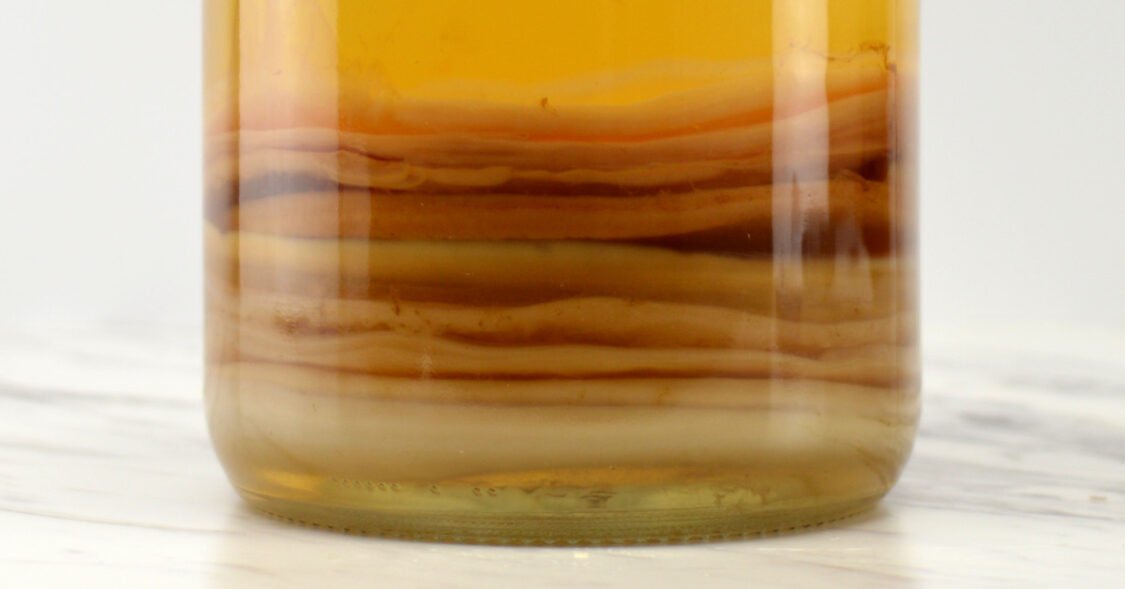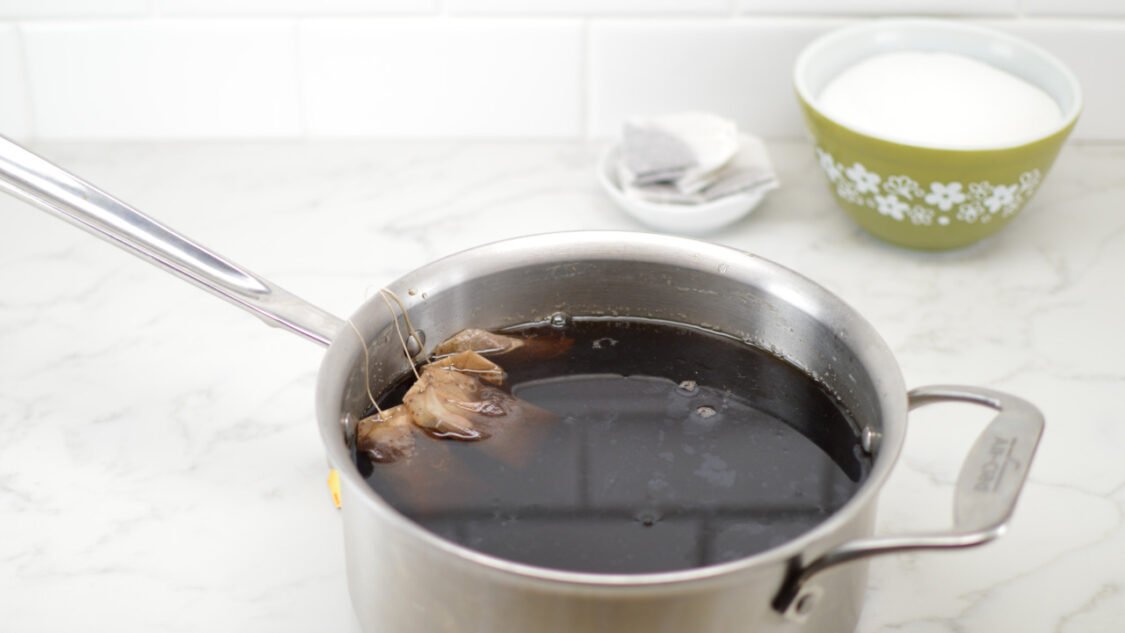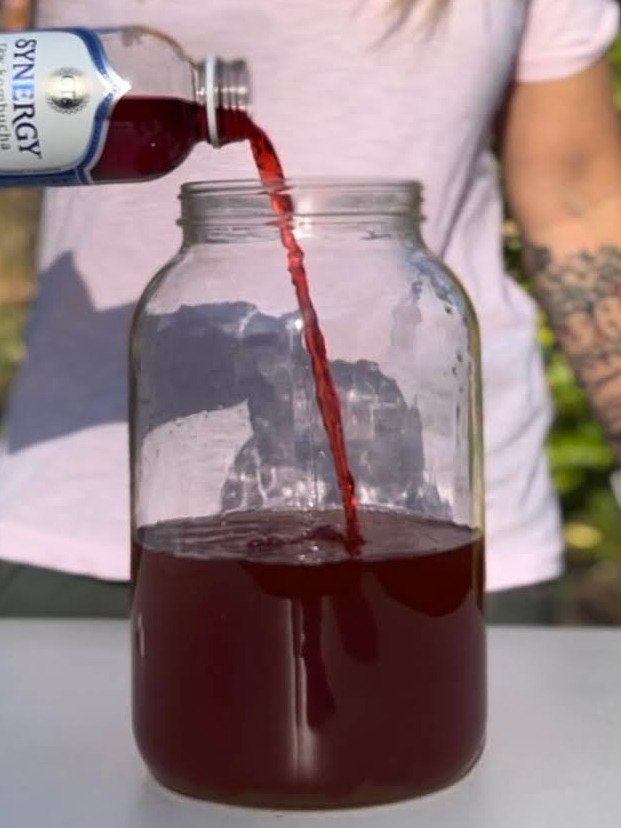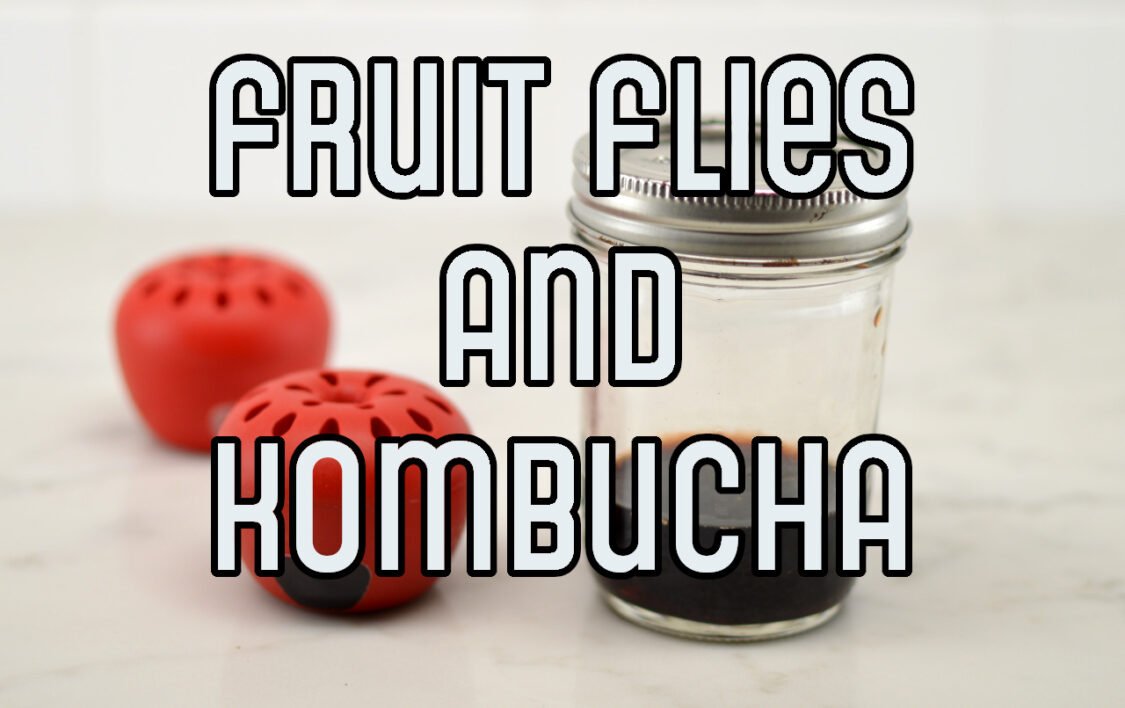All about SCOBY Hotels
If you have made made a few batches of kombucha, you will likely have extra kombucha SCOBYs. This guide has everything you need to know about making and maintaining a Kombucha SCOBY Hotel.

Nearly every time you make a new batch of kombucha, your SCOBY replicates itself and created a new SCOBY. Sometimes the mama SCOBY will sink and the baby SCOBY will form on the surface of the fermenting Kombucha. Other times the mama will continue to float and the new baby SCOBY will be attached on top of original (mama) SCOBY.
Besides eating them or composting you can also start a SCOBY hotel to have a supply of backup SCOBYs in case something goes wrong with your main brew.

What is a SCOBY Hotel?
In simplest terms a SCOBY hotel is a jar with kombucha liquid culture where you store extra Kombucha SCOBYs when they are not needed. The SCOBYs inside are not actively fermenting Kombucha, they are in a dormant state–ready to jump to action when needed.
A kombucha SCOBY can last for quite a long time and provide you with a continuous supply of fresh, homemade kombucha. Storing a few in a SCOBY Hotel ensures you will always have a healthy SCOBY available to keep brewing kombucha.
Why do I need a SCOBY Hotel?
There are many good reasons to create and maintain a SCOBY hotel. Here are some of the best reasons:
- Somewhere for extra kombucha SCOBYs to rest
- A source for backup SCOBYs in case of mold or declining performance of your main SCOBY
- A replacement SCOBY if you want to conduct an experiment with a new tea, coffee, sugar or anything else
- You will have SCOBYs to share with friends and family
- A supply of ready to use SCOBYs for cooking and eating
- A source of fermented starter culture which you can use to create a new SCOBY or start a new fermentation

How to Make a SCOBY Hotel
Making a SCOBY hotel is easy, all you have to do is put all of your extra SCOBYS into a clean glass container along with some room temperature sweet tea and unflavored kombucha (just like making kombucha!).
An one gallon glass fermentation jar is an ideal container for a SCOBY hotel and If you’re already using gallon glass jars for brewing kombucha, you can set one aside for your SCOBY hotel.
Some kombucha brewers use other containers, like glass mixing bowls, crock pots or lexan containers; however, glass jars have an advantage over both: the size of the jar keeps the SCOBY from growing wider than the jars you normally use, and the glass lets you quickly spot any problems like mold or foreign objects in the liquid.
Supplies to make a SCOBY hotel
- Large pot for boiling water
- Large glass or ceramic container (no plastic or metal) I prefer a 1 Gallon Wide Mouth Mason Jar or a two pack (affiliate links
)
- Long-handled spoon like these (affiliate link
)
- Tightly woven cloth (clean tea towels, coffee filters, paper towels, napkins, cheese cloth) I like to use cheesecloth (affiliate link
)
- Rubber bands or twine to keep the cloth on the fermentor
Ingredients for a SCOBY hotel
- 7 cups (1.6L) water
- 4 bags (7 g) black tea (not decaf) (see my article on the best teas for kombucha)
- 1/2 cup (100 g) white sugar 1 cup (240 mL)
- 1 cup (200 g) unflavored, unpasteurized kombucha (homemade or store-bought)
How to make a SCOBY hotel
1. Make Sweet Tea: Bring water to a boil. Remove from heat and dissolve sugar into it. Add the tea bags and allow them to steep for at least 20 minutes (or until tea has cooled).

2. Cool Tea to Room Temp: Allow hot tea to cool to room temperature. Cooling can be quickened by boiling only 2 cups of water, dissolving the sugar, and steeping the tea in that water for 20 minutes. Next add the remaining 5 cups of cold water, which will rapidly cool the mixture close to room temperature. Make sure the sweet tea mixture is totally cooled-kombucha is sensitive to temperature.
3. Build: Add all of your extra SCOBYs to the clean, dry fermenting jar
4. Add Starter: Pour the sweetened tea into your fermentation jar, then pour in the store-bought kombucha, swirling the bottle a couple times to ensure the sediment at the bottom of the kombucha is goes into the fermenter. Ensure the SCOBYs are covered by liquid (one may float on top, this is OK)

5. Cover: Cover with of choice and secure with a rubberband around neck of fermenter
6. Store: Keep your SCOBY hotel at room temperature (65-85F is ideal)
If this sounds like the process for making a batch of new kombucha well, it is! It’s exactly the same process, except you are “checking in” your extra SCOBYs into the hotel jar. Over time it will likely contain quite a few SCOBYs–I’ve had 10 or more in a single jar!–and, unlike your regular batches, you won’t have to monitor it or add new sweet tea for a couple months.
How to care for a SCOBY Hotel
Maintaining a SCOBY hotel is pretty simple and mostly hands off. Here are some basic tips to keep your hotel running smoothly:
- Keep it covered – ensure your SCOBY hotel is always covered with the cloth and that the liquid inside does not dry up. If the level falls, add some additional cooled sweet tea.
- Keep it cool – storing it on the cooler end of the range will slow down the activity of the SCOBYs inside and keep the hotel actively feeding for longer. Storage at temperatures below 45F can harm the SCOBY though, so an ideal place would be in a basement or pantry that stays around 50F to 55F. That’s cool enough to keep the SCOBY dormant, but not so cold to hurt it.
- Clean it – after a while you may notice an accumulation of brown residue between layers and at the bottom of the jar. This is dormant kombucha yeast and can be discarded to maintain a good bacteria / yeast balance.
- Feed it -At first you can just add in a cup of sugar to the hotel which will dissolve and supply food for your SCOBYs. Your tea mixture will get lower and more concentrated over time as it it evaporates in time, so you will need to add some water once in a while as well.
After a few months of this though (say after 12 weeks or about 2 times of feeding it this way twice), you will want to replace the old sweet tea with a fresh batch of cooled sweet tea. First remove some of the excess yeast buildup at the bottom of the jar and and trim some of the thicker SCOBYs then add the fresh sweet tea.
How Long Can A SCOBY Hotel Survive Without Fresh Tea?
I recommend you replace about 80 percent of the SCOBY Hotel liquid with fresh sweat tea every 2 or so months (or at least add in 1 cup of sugar if you don’t want to change the tea), it’s possible that if you just leave your SCOBY Hotel alone the SCOBYs will be fine for 4 to 6 months, even without any refill.
This is especially true if it’s stored in a cooler location where the SCOBYs are less active. I’ve heard of a few cases where people left a SCOBY in a jar for a year and the SCOBY was still usable.
How to use a SCOBY Hotel
Once your kombucha SCOBY hotel is up and running what do you do when you need a SCOBY from it or some starter liquid?
- Adding a “guest” to the hotel – uncover the fermenter and gently add the SCOBY. I will often add the mother SCOBY to the hotel and use the new “baby” for my next batch
- “Checking Out” a SCOBY – simply uncover the fermenter and remove the SCOBY with clean hands. To ensure your SCOBYs stay their healthiest, rotate between active SCOBYs and ones in the SCOBY Hotel so that they are all getting used and exposed to fresh tea and sugar on a regular basis. This will keep them active and ready to ferment your next batch of kombucha.
- Use starter liquid from hotel – Make a small batch of sweet tea to replace the amount you are removing and allow to cool. Remove the amount of starter culture needed and replace with cooled sweet tea.

Kombucha SCOBY Hotel Tip & Tricks
Caring for your SCOBY hotel is easier than making great kombucha! Here are some tips to ensure success:
- Keep at room temperature – don’t refrigerate or freeze
- Consider rotating SCOBYs to encourage culture diversity
- SCOBY hotels rarely grow mold due to the strength (acidity) of the starter culture
- Use cooled sweet tea with starter liquid only. Water and unsweetened tea are not sufficient to ensure your SCOBYs remain healthy
- Keep it covered – maintain the cloth covering to keep out bugs (fruit flies) and ensure it can breathe
SCOBY Hotel Deep Cleaning
Think of this as spring cleaning of your SCOBY hotel.
Ideally, you should do this every 8-12 weeks (2-3 months), or whenever you see a large amount of material at the bottom of the jar, to keep your SCOBYs healthy.
While it’s possible you can just abandon your SCOBYs for 6 months or a year by just leaving them in a jar, your cultures may degrade. Healthy SCOBYs mean better tasting, healthier Kombucha.
Both live and dead microorganisms from the colony will begin to accumulate at the bottom of the jar over time. Many of these will be the brownish yeast cells that you normally see in kombucha. By cleaning out your SCOBY hotel regularly, you can help keep the balance of yeast and bacteria in the correct proportion. To clean the hotel, you’ll need:
Supplies for a Deep Cleaning
- Clean glass bowl large enough to hold the SCOBYs
- Another clean bowl or pitcher large enough to hold the liquid from the hotel
- Clean cloths to cover the bowls
- Extra kombucha tea (unflavored) aka starter liquid
- Fresh batch of brewed sweet black tea, cooled
Step 1: Inspect SCOBYs
Be sure to wash your hands well before handling the SCOBYs.
As you take each SCOBY out of the hotel, examine it to make sure that it doesn’t have any dead or moldy spots. You can use a stainless steel knife to trim off any ragged edges, if you like. You can also cut or peel off the lower layers that are darker and have yeast strands hanging off them. These are the oldest and least active layers.
You’ll find that the SCOBYs will grow very thick inside the hotel jar. The longer your SCOBYs sit, the bigger and thicker they will grow. Too many thick SCOBYs can block out the oxygen from from the top part to the bottom areas of the jar. Thus, it’s a good idea to trim down some of your SCOBYS so there’s an equal distribution of oxygen in the jar.
Keeping the SCOBY to a thickness of about 1 inch will help keep the colony in good shape. If your SCOBY is thicker, you can trim the SCOBY as follows:
- Take the top layer of SCOBY from the jar
- Peel the layers apart. Sometimes you can peel multiple layers off. If you tear parts of it, don’t worry — you are not hurting the SCOBY. If you can’t peel the layers by hand, take a knife or scissors, sterilize it with rubbing alcohol, then trim the SCOBY — either cut it horizontally or vertically. The goal here is to trim it so it’s thinner.
- Any extra parts you cut off from the main bunch, you can toss in the compost. By the end of your trimming, you should have multiple thinner SCOBYs or a couple different ones you cut in half (half the width they were), or a single much thinner SCOBY. Note: you can use trimmed pieces of SCOBY as new SCOBYs for kombucha brew if you want to.
- Put each SCOBY into the clean glass bowl as you finish, and pour a little kombucha over it. Cover the bowl with a clean cloth to keep out dust and insects.
Step 2: Filter the Starter Liquid
Yeast is important to your culture, but too much of it can cause an imbalance during fermentation. Remember that SCOBY is a symbiotic relationships between bacteria and yeast. Too much of one creates an imbalance.
You’ll see the yeast strands often hanging from the bottom of your SCOBYs. The strands often fall and accumulate at the bottom of the jar. In time, the yeast can build up quite a bit and too much of it can cause an imbalance in the ratio of bacteria to yeast.
Carefully pour the liquid out of the SCOBY hotel through a strainer and/or cheesecloth into the other clean bowl, and cover it with a clean cloth.
You’ll notice strands of the SCOBYs will remain in the mesh material you use to filter. These are yeast strands filtering the liquid removes extra yeast from the SCOBY Hotel.
You will use some of this liquid you filtered through to make the 50/50 mixture of starter culture and sweet tea when you put the SCOBYs back in the hotel. If you have extra, you can use it as the starter culture for a new batch of kombucha.
Step 3: Clean the Jar
Use hot water to rinse out the jar. If the bottom and sides of the jar are coated with some of the dead microorganisms, and they’re not coming off with a simple rinse, then use a mild soap to scrub the jar, and rinse again with hot water.
Step 4: Rebuild the Hotel
Mix equal amounts of the starter liquid and the fresh sweet black tea and pour some of it into the cleaned hotel, then put the SCOBYs back in and cover them with the rest of the mixture. If your SCOBYs fill up more than two-thirds of the jar, it’s better to create a second hotel for the extras, rather than trying to cram them all into one place.
If you have too many SCOBYs and don’t know what to do with them, you can look online for the kombucha brewing forums in your area, and see if there’s anyone out there who wants a SCOBY, add them to your compost or find a recipe to use them in.
Helping you learn to brew kombucha, find inspiration for new kombucha flavors and use kombucha to make kombucha mocktails

 )
)


